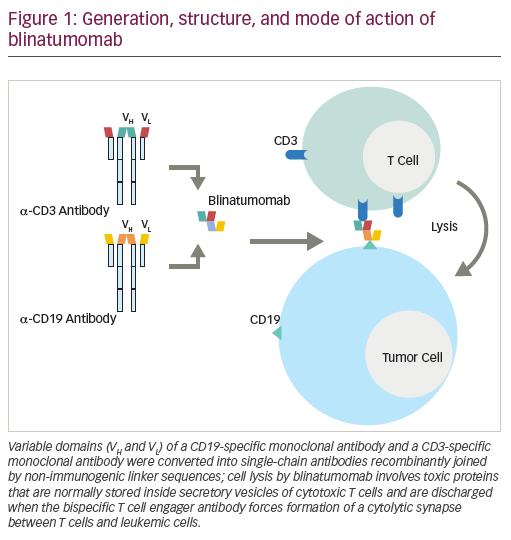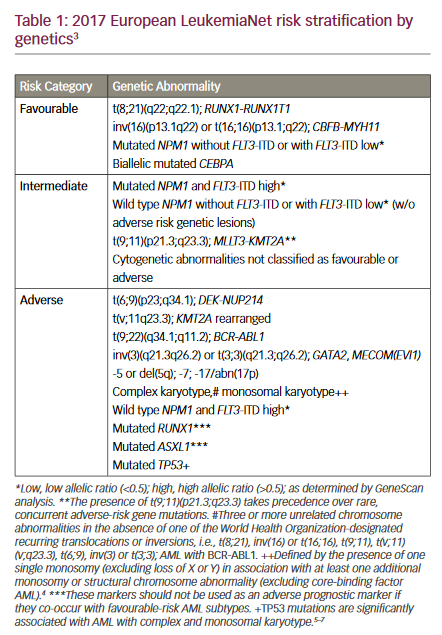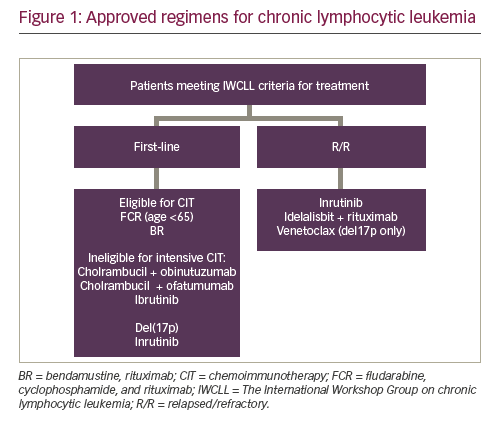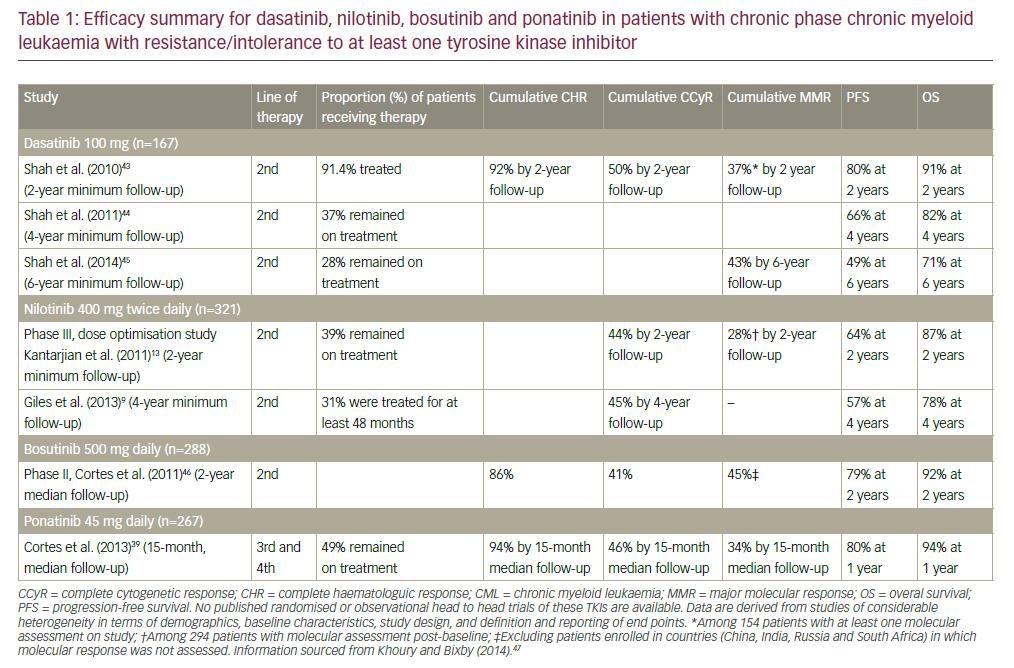Since the introduction of the tyrosine kinase inhibitors (TKIs), management of chronic myeloid leukemia (CML) has undergone remarkable change. CML is characterized by the presence of the Philadelphia chromosome (Ph), which is formed by the reciprocal translocation of genetic material between chromosomes 9 and 22, t(9;22)(q34;q11). This translocation leads to the fusion of the BCR and the ABL1 genes, and the resultant bcr-abl gene encodes the p210bcr-abl fusion protein, a constitutively active tyrosine kinase. The bcr-abl gene has been implicated in the etiology of CML, and it causes reduced apoptosis and uncontrolled proliferation through the activation of several signal transduction pathways.
Traditional treatments prior to imatinib include hydroxyurea, busulfan, recombinant interferon-α (IFN-α) alone or in combination with cytarabine, and allogenic stem cell transplantation. The elucidation of the molecular pathogenesis of this disease led to the development of the molecularly targeted TKIs. Imatinib mesylate (Gleevec®, Novartis Pharmaceuticals, Switzerland), a first-generation TKI, has become the standard treatment of CML, and TKIs as a class can effectively inhibit malignant cell growth and disease transformation in most patients with CML. This article will discuss the available TKI treatment options and evaluate optimal treatment algorithms for patients with CML.
Response Monitoring Schedule During Treatment of Patients with Chronic Myeloid Leukemia
The response monitoring schedule for the assessment of therapeutic efficacy includes assessment of hematological, cytogenetic, and molecular responses at defined time-points (see Table 1).1–3 Assessment of the molecular response is considered particularly important in CML therapy as it can provide valuable information in the follow-up of CML patients. For instance, it has been correlated with cytogenetic response,4,5 and has been shown to be a predictor of progression-free survival6 and relapse.2 Molecular response is assessed by measuring the bcr-abl transcript levels. The transcript bcr-abl levels in samples of both bone marrow and peripheral blood of Ph+ CML patients have been correlated to the number of residual leukemic cells in the sample (see Figure 1).2 Realtime quantitative polymerase chain reaction (RQ-PCR) is used to measure transcript levels; this technique is very sensitive, being able to detect a single bcr-abl-positive cell among up to 105–106 normal cells.4,7,8
Imatinib as a First-line Therapy in Patients with Chronic-phase Disease
Imatinib is a selective inhibitor of bcr-abl tyrosine kinase and other tyrosine kinases (c-Kit, platelet-derived growth factor receptor [PDGF-R], arginine [ARG]). It can inhibit kinase activity by binding to the ABL domain at the adenosine triposphate (ATP)-binding site and trapping the protein in an inactive conformation. The International Randomized Study of Interferon and ST1571 (IRIS) trial established imatinib as the standard initial therapy for patients with chronic-phase CML (CML-CP). Newly diagnosed CML-CP patients (n=1,106) were randomized to receive either imatinib (400mg daily [QD]) or IFN-α) plus cytarabine (Ara-C). The study showed a significantly greater complete cytogenetic response (CCyR) rate in imatinib-treated patients compared with patients who were administered first-line therapy with IFN-α plus low-dose Ara-C (76.2 versus 14.5%; p<0.001; median follow-up 19 months).9 Freedom from progression to more advanced-stage disease was higher in the imatinib group compared with the IFN-α group (96.7 versus 91.5%; p<0.001), and five- and six-year follow-up data showed that these responses were durable in the majority of the patients who received continuous imatinib treatment.6,10 The long-term survival associated with imatinib exceeds the reported overall survival (OS) for all other CML therapies. The six-year OS rate in the imatinib group was estimated at 88%, while it was 95% when considering only CML-related deaths.10 Imatinib is currently approved by the US Food and Drug Administration (FDA) as first-line therapy for patients with CML based on data from the IRIS trial. The US National Comprehensive Cancer (NCCN) recommends initial therapy of CML-CP with imatinib (400mg QD) as standard treatment.3 Continuation of therapy on the same dose of imatinib is indicated for patients who respond to initial treatment and achieve: a hematological remission at three months of evaluation; a partial, minor, or complete cytogenetic response (CCyR) at six months of evaluation; a partial CyR or CCyR at 12 months of evaluation; or a CCyR at 18 months of evaluation.3
Resistance to TKIs may develop in some patients with CML and is manifested by either a suboptimal response to or failure of therapy. Primary resistance to imatinib (failure to achieve the desired response at specified times despite having adequate treatment) is rare and may be due to inadequate imatinib dose (i.e. lack of patient compliance to the drug).11–13 Secondary resistance or loss of response may arise from acquired resistance to bcr-abl inhibition, which may be due to diverse mechanisms of resistance to TKIs. Mechanisms of resistance include decreased imatinib bioavailability or cell exposure, bcr-abl oncogene amplification or overexpression, point mutations within the ABL activation site, and cytogenetic clonal evolution.14–16 Fewer than 5% of Ph+ CP-CML patients per year exhibit imatinib resistance. Imatinib resistance primarily occurs in the advanced phases of Ph+ CML and appears within three to six months of initiating therapy.17 Some studies have associated imatinib resistance with poor prognosis,18 while others have found that patient prognosis is dependent on disease stage and not mutational status.19 The IRIS study showed that the number of patients who progress to advanced disease declines over time, and early treatment may prevent progression.10
Imatinib Dose Escalation to Optimize Imatinib Therapy
Imatinib dose escalation has been investigated in patients who do not respond to standard dose as no dose-limiting toxicities have been found at a higher dose of imatinib.20 The rationale for this strategy is that mutations resulting in the overexpression and amplification of bcr-abl could potentially be overcome by higher concentrations of imatinib.2,17
Although there is evidence on the efficacy of imatinib dose escalation (600–800mg QD), in some studies responses were short-lived.21–23 A retrospective analysis of the IRIS trial supports imatinib dose escalation as an appropriate initial option for patients with CML-CP who were experiencing suboptimal cytogenetic response or resistance.24 Clinical responses were seen in 54 and 44% of patients who were dose-escalated to 600 or 800mg QD according to the IRIS protocol and the European Leukemia Network (ELN) recommendations at 12 months of follow-up, respectively.24 OS and rates of freedom from progression to accelerated phase (AP) or blast phase (BP) were 84 and 89%, respectively, in patients with newly diagnosed CML-CP who underwent imatinib dose escalation.24 These results are consistent with a previous trial that indicated that imatinib dose escalation to 800mg QD may effectively treat patients with CML-CP who fail to achieve a cytogenetic response to standard-dose imatinib.25 Imatinib dose escalation from 400 to 600mg QD is FDA-approved in the US for patients with CML-CP. The NCCN recommends dose escalation to a maximum of 800mg QD in patients with CML who fail standard-dose imatinib as well as those who achieve only a suboptimal response with first-line therapy with standard-dose imatinib at specified time-points.3
Treatment Options for Patients with Imatinib-resistant or –intolerant Chronic Myeloid Leukemia
Changing treatment to second-generation TKIs has been investigated in patients with inadequate primary response, loss of response, or disease progression with imatinib therapy. The second-generation TKIs dasatinib (Sprycel®, Bristol-Myers Squibb, US) and nilotinib (Tasigna®, Novartis Pharmaceuticals, Switzerland) have recently been approved by the FDA for the treatment of patients with imatinib-resistant or -intolerant CML.
Dasatinib
Dasatinib is an orally available dual inhibitor of the bcr-abl/SRC kinases. It can bind the ABL kinase in both the inactive and the active conformation26,27 and has a 325-fold greater binding than imatinib against unmutated bcr-abl in vitro.26 The SRC/ABL Tyrosine kinase inhibition Activity: Research Trials of dasatinib (START) program has evaluated dasatinib (70mg twice daily [BID]) in patients with imatinib-resistant or -intolerant Ph+ CML.28–38 These studies established that dasatinib could induce cytogenetic responses in all phases of CML in patients who had previously failed imatinib therapy due to resistance or intolerance (see Table 2). Progression-free survival (PFS) and OS rates at two-year follow-up were 80 and 94%, respectively, in patients with chronic-phase disease,39 while a PFS rate of 76% was noted in patients with CML-AP at eight-month follow-up.29 In the international open-label, randomized START-R phase II study, dasatinib (70mg BID) was shown to induce greater and more durable CCyR in patients with 400–600mg QD imatinib-resistant or -intolerant CML-CP compared with imatinib dose escalation to 800mg QD.31,40 Data from the START trials also demonstrated high major molecular response (MMR) rates in dasatinib-treated patients, with 12, 22, 35, and 40% of patients achieving an MMR after three, six, 12, and 24 months of follow-up, respectively.41
Some of the most common grade 3/4 adverse effects associated with dasatinib are summarized in Table 3.42–44 Dasatinib was usually well-tolerated in the START program. Based on the results of this program, the FDA approved dasatinib (70mg BID) in patients with imatinib-resistant or -intolerant CML-CP, CML-AP, and CML-BP. A subsequent phase III dose-optimization study in patients with imatinib-resistant or -intolerant CML showed similar efficacy of dasatinib dosing regimens of 100mg QD and 70mg BID, with significantly lower incidences of pleural effusions and grade 3 or 4 cytopenias with the former compared with the 70mg BID dose.45 Based on this study, a 100mg QD dasatinib dose was approved by the FDA for therapy in imatinib-resistant or -intolerant Ph+ CML-CP. The NCCN guidelines indicate a change of treatment to dasatinib as an option in patients with imatinib-resistant or -intolerant CML-CP.3 The guidelines also recommend dasatinib as a treatment option in patients who progress to or are diagnosed in the accelerated or blastic phases of CML.
Nilotinib
Nilotinib is an orally available selective inhibitor of bcr-abl tyrosine kinase. It can bind to the ABL domain with a higher affinity and improved topological fit compared with imatinib. An initial phase I study showed that nilotinib was active and tolerable in all phases of imatinib-resistant CML.46 Subsequently, a phase II open-label trial demonstrated activity of nilotinib (400mg BID) as second-line therapy in adult patients with imatinib-resistant (treatment failure) or -intolerant and -resistant Ph+ CML-CP and Ph+ CML-AP. Follow-up efficacy data for the study are summarized in Table 4.44,47,48 Compared with historical controls of imatinib, six months of nilotinib treatment resulted in earlier MMRs, with higher rates than achieved with imatinib (see Table 5).6,49,50 The 18-month OS and PFS rates in CML-AP patients were 79 and 57%, respectively.44,47,51
Nilotinib was generally well-tolerated in this study (see Table 3). The clinical efficacy and tolerability of nilotinib (400mg BID) in these subsets is consistent with the results of other phase II studies.36,37,51,52 Nilotinib (400mg BID) is approved by the FDA for the treatment of patients with imatinib-resistant or -intolerant Ph+ CML-CP and Ph+ CML-AP. The NCCN recommends nilotinib (400mg BID) as a treatment option in patients with imatinib-resistant or -intolerant CML-CP, as well in patients who progress to or are diagnosed with CML-AP.3 Nilotinib has also been evaluated in patients with imatinib-resistant or -intolerant Ph+ CML-BP. Preliminary data show activity of nilotinib (400mg BID), with a 12-month OS rate of 42%.48 However, disease progression resulted in a discontinuation rate of more than 50%.
Choosing Between Second-generation Tyrosine Kinase Inhibitors
The NCCN guidelines for CML state that the choice between the approved second-generation TKIs dasatinib and nilotinib should be based on several practical considerations,3 including the side-effect profile of the drug, patient comorbidities, drug–drug interactions, type and stage of disease, mutational status, and other practical considerations.
It is vital to consider the side-effect profile of both dasatinib and nilotinib (see Table 3) when selecting the appropriate second-line therapy. Importantly, there is a risk for pleural effusion with dasatinib, especially in patients with prior cardiac history and hypertension,53 while the FDA label warns of a risk of QTc prolongation with nilotinib, and it should be taken on an empty stomach. In terms of drug–drug interactions, both dasatinib and nilotinib seem to have a lower potential for drug interactions than imatinib. Nevertheless, the concomitant use of dasatinib or nilotinib with CYP3A4 inhibitors or CYP3A4 inducers is not recommended. Warfarin, antacids, and proton pump inhibitors are contraindicated in patients receiving dasatinib, while strong CYP3A-4 inhibitors or agents that prolong QT are contraindicated in patients receiving nilotinib. Bcr-abl mutations are a major mechanism of imatinib resistance, and therefore the effect of the second-generation TKIs on these mutations needs to be considered. Both dasatinib and nilotinib can inhibit imatinib-resistant mutants (except T315I), but with differential efficacy against other mutations. Dasatinib is associated with clinical resistance to mutations in specific amino acids, such as V299, T315, and F317.54–57 Nilotinib has demonstrated high efficacy in patients with CML-CP carrying F317 mutations; however, in vitro and clinical studies have demonstrated that certain mutations occurring in the P-loop (Y253F/H, E255K/V) and in amino acid F359 are 10- to 35-fold less sensitive to nilotinib compared with unmutated bcr-abl.26,37,52,57–61 In CML patients who are intolerant to imatinib, the cross-intolerance profile of the second-generation TKIs versus imatinib needs to be considered. Preliminary data have shown minimal cross-intolerance between dasatinib and imatinib in patients with imatinib-resistant or -intolerant CML-CP, while there is minimal cross-intolerance between nilotinib and imatinib in patients with imatinib-resistant or -intolerant CML-CP and CML-AP. Depending on the disease phase, nilotinib or dasatinib may be suitable approaches in imatinib-intolerant CML patients (see Table 6).62,63
In the future, as more data become available, identification of the type of mutation present may help to identify the subset of patients with CML most likely to benefit from nilotinib, dasatinib, or newer drugs. At present, current guidelines indicate that the choice of second-line agent should primarily be driven by clinical risk–benefit profile rather than the results of mutational analysis, with the exception of the T315I mutation.3
Re-evaluating the Treatment Strategy in Imatinib-resistant Patients
Earlier responses to imatinib therapy in patients with CML have been suggested to correlate with better outcomes.4,64–68 Conversely, patients achieving a suboptimal response to imatinib have been shown to have an inferior prognosis compared with those achieving optimal response.69,70 Thus, early identification of patients with a suboptimal response to imatinib therapy may allow for timely intervention of new therapy and an improvement in patient prognosis. Increasing the frequency of monitoring of the response to imatinib may also be another strategy to optimize treatment. Among the TKIs, only imatinib dose escalation has been recommended by the National Comprehensive Cancer Network (NCCN) in patients who respond suboptimally to initial therapy with standard-dose imatinib.3 The use of nilotinib in patients who respond suboptimally to imatinib therapy is being evaluated. A randomized, open-label phase III trial (NCT00519090)71 of patients with CP-CML who have had a suboptimal response to standard-dose imatinib investigated the efficacy of nilotinib versus escalated-dose imatinib (800mg QD) in this patient group; this trial has recently been completed, while another trial (NCT00802841)72 is ongoing. The previously mentioned dasatinib phase III START-R study suggested that patients with CML-CP showing suboptimal response to prior imatinib therapy might benefit from dasatinib.45 Furthermore, a recent analysis of a trial in CML-CP patients showed that earlier initiation of treatment with dasatinib after relapse during imatinib therapy led to extended PFS and higher response rates.73 Results from an ongoing trial (NCT00320190)74 comparing the efficacy of dasatinib versus imatinib dose escalation in patients with suboptimal response to standard-dose imatinib should further address this treatment strategy. Further research should identify whether this novel approach of changing treatment from imatinib to the second-line agents at an earlier time-point (i.e. after suboptimal response) is a viable strategy.
Options Under Investigation for First-line Treatment of Chronic-phase Disease
High-dose imatinib (600–800mg QD) has been evaluated in newly diagnosed previously untreated CML-CP patients and has been associated with moderate to high cytogenetic and molecular responses.64,75,76 High-dose imatinib has also been shown to induce increased CCyR and molecular responses compared with standard-dose imatinib.64 In a study where 114 patients with newly diagnosed CML-CP were treated with 400mg BID imatinib, no patients progressed to advanced disease stages at a median follow-up of 15 months, and the two-year OS was estimated at 94%.64
The efficacy and tolerability of both dasatinib and nilotinib have led to their evaluation as front-line therapy in patients with CML-CP. Interim results of a phase II trial evaluating the efficacy and safety of dasatinib in patients with previously untreated CML-CP have been presented in the abstract form.77 Patients were randomized to either 50mg BID or 100mg QD dasatinib dosing schedules. About 34% (12/35) of the evaluable patients reached the primary end-point of MMR at 12-month follow-up. At a median follow-up of 24 months, 98% (44/45) of the evaluable patients achieved a CCyR. The CCyR response with dasatinib was faster than with imatinib as a greater number of patients treated with dasatinib achieved a CCyR at three-, six-, 12-, or 18-month follow-up compared with historical controls of imatinib (400 or 800mg QD). Both doses of dasatinib were shown to be well-tolerated as there was a low incidence of grade 3/4 hematological and non-hematological toxic events. An ongoing open-label, randomized, multicenter phase III trial (NCT00481247)78 is comparing the CCyR rate of dasatinib versus that of imatinib (400mg QD) in newly diagnosed Ph+ CML-CP. The results of this study will help identify the role of dasatinib as first-line therapy in patients with CML-CP.
An open-label, single-stage, multicenter phase II trial has evaluated the efficacy and safety of nilotinib 400mg BID in patients with Ph+ early CML-CP. Interim results from 71% (52/73) patients have been presented in the abstract form and showed that the primary end-point of CCyR at 12-month follow-up was met in 90% of the intention-to-treat population.79 There was a 59, 66, and 77% MMR rate after three-, six-, and 12-month follow-up, respectively. Nilotinib showed a good tolerability profile, with adverse events being commonly grade 1 and 2, and easily manageable. Furthermore, the CCyR response with nilotinib was faster than that with imatinib as a greater number of patients treated with nilotinib achieved a CCyR at three- and six-month follow-up compared with historical controls of imatinib (400 or 800mg QD).49,79 An open-label, randomized, multicenter phase III trial (NCT00471497)80 comparing the efficacy and safety of two doses of nilotinib (300 and 400mg BID) with imatinib (400mg QD) in newly diagnosed Ph+ CML-CP patients is ongoing.
Conclusions
Imatinib (400mg QD) is the standard first-line therapy in patients with CML-CP. Imatinib dose escalation up to 600 or 800mg QD is recommended by the NCCN guidelines as an option for patients who respond suboptimally to the starting dose of imatinib. The second-generation TKIs nilotinib and dasatinib are recommended for patients with imatinib-resistant (treatment failure) or imatinib-intolerant CML-CP, or those who progress to or are diagnosed with advanced disease. Whether dasatinib or nilotinib is chosen as second-line treatment should be based on the disease phase, the side-effect profile of the drug, drug–drug interactions, and patient comorbidities, among other practical considerations. Changing treatment from imatinib to the second-generation TKIs in patients with CML-CP who show suboptimal or inadequate response to first-line imatinib seems to be a promising approach, and clinical investigations are under way. First-line therapy with high-dose imatinib, dasatinib, or nilotinib may also be an improvement over standard first-line therapy with imatinib (400 QD) in the future. Data from trials evaluating these novel treatment approaches will hopefully provide options for further improving treatment outcomes in patients with CML, as well as preventing disease progression. ■













